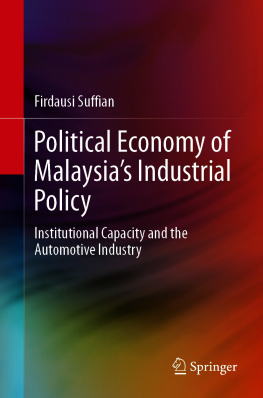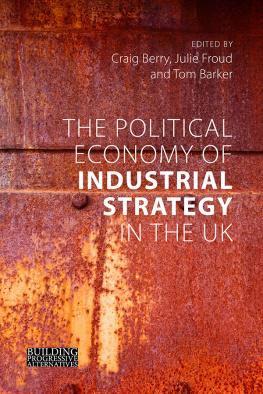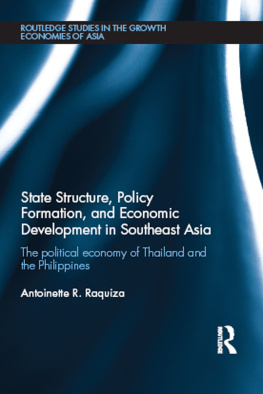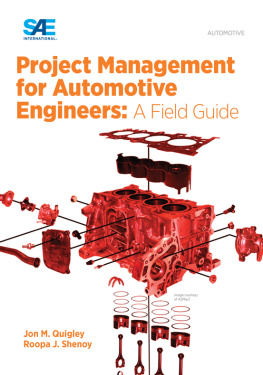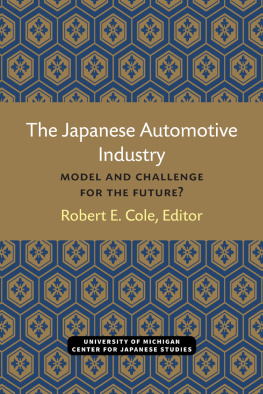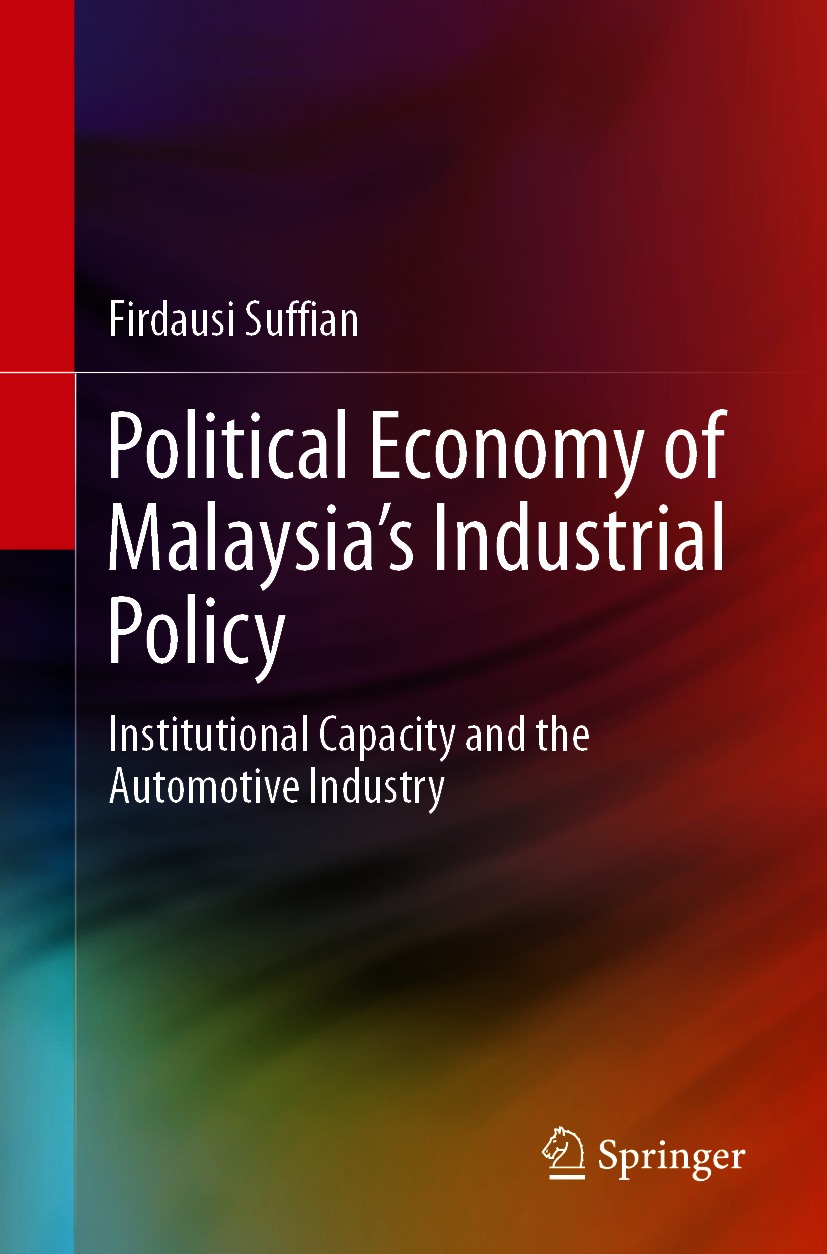Firdausi Suffian
Political Economy of Malaysias Industrial Policy
Institutional Capacity and the Automotive Industry
1st ed. 2021

Logo of the publisher
Firdausi Suffian
Faculty of Administrative Science and Policy Studies, Universiti Teknologi MARA, Kota Kinabalu, Sabah, Malaysia
ISBN 978-981-33-6900-9 e-ISBN 978-981-33-6901-6
https://doi.org/10.1007/978-981-33-6901-6
The Editor(s) (if applicable) and The Author(s), under exclusive license to Springer Nature Singapore Pte Ltd. 2021
This work is subject to copyright. All rights are solely and exclusively licensed by the Publisher, whether the whole or part of the material is concerned, specifically the rights of translation, reprinting, reuse of illustrations, recitation, broadcasting, reproduction on microfilms or in any other physical way, and transmission or information storage and retrieval, electronic adaptation, computer software, or by similar or dissimilar methodology now known or hereafter developed.
The use of general descriptive names, registered names, trademarks, service marks, etc. in this publication does not imply, even in the absence of a specific statement, that such names are exempt from the relevant protective laws and regulations and therefore free for general use.
The publisher, the authors and the editors are safe to assume that the advice and information in this book are believed to be true and accurate at the date of publication. Neither the publisher nor the authors or the editors give a warranty, expressed or implied, with respect to the material contained herein or for any errors or omissions that may have been made. The publisher remains neutral with regard to jurisdictional claims in published maps and institutional affiliations.
This Springer imprint is published by the registered company Springer Nature Singapore Pte Ltd.
The registered company address is: 152 Beach Road, #21-01/04 Gateway East, Singapore 189721, Singapore
To my family.
Foreword
In the annals of industrialisation, Malaysia has achieved a double first. It was the first Muslim-majority country to industrialise and most unusually for a capitalist economy, it has done so with a redistribution policy at the heart of its development project. Given that it is also one of the only two multiracial industrialised countries in East Asia (the other is Singapore), Malaysia could well stand as a beacon of hope to other countries of the Global South that have yet to industrialise. Unfortunately, Malaysias ability to be seen as a development guide now seems less credible than it was 20 years ago. Dr. Suffians excellent interrogation of the political economy of Malaysias automobile industry helps us understand the challenges industrialising the country and institutional constraints
With independence in 1957, what later became the new country of Malaysia was bequeathed four important legacies by its British colonisers: an economy composed of plantation and peasant agriculture, tin mining and trade-based commerce; a racial division of labour (Malay/Bumiputra, Chinese, Indian) that reflected the economic structure; poverty and inequality that partly reflected the division of labour; and a bifurcation of power whereby Chinese Malaysians largely controlled the economy and Malays/Bumiputra, the state. Perhaps inevitably, the contradictions inherent in these arrangements led to interracial conflict in the late 1960s. For the Malaysian government, the way forward was industrialisation (thus increasing employment and reducing poverty) and this was achieved largely by means of foreign investment in the assembly of electronics products.
By the 1980s a concern to emulate the Northeast Asian economies led to a heavy industrialisation programme of which the centrepiece was an automobile industry. Driven by economic nationalism, the first auto firmProtonwas initially a joint venture between the states Heavy Industries Commission and Mitsubishi. Complemented by the Perodua brand in the 1990s and protected from foreign imports by very high tariffs (up to 300% until the mid-2000s) on the domestic market, the national car projectin terms of production scale, innovation, skill upgrading and export market penetration has beenat besta limited success. In terms of the states redistribution agenda, however, it has been more successful. Whereas the opportunities for local firm linkages created by the electronics subsidiaries were seized by Chinese Malaysian entrepreneurs, thanks to state patronage, those spawned by the national car project were made available to Bumiputra ones.
In The Political Economy of Malaysias Industrial Policy: Institutional Capacity and the Automotive Industry, Firdausi Suffian meticulously charts the politicaleconomic dynamics and considerations that forged and continue to influence the development of Malaysias auto industry. In so doing he shows how the articulation of elite interests with the states redistributional agenda has helped deliver the industryfor better or worseto its current condition. While other books have analysed this scene at a macro level, this is the only one to have drilled down into the interstices of an industry essential to Malaysias socio-economic development project. In this very important contribution, Dr. Suffian exposes some of the detail of why Malaysia may have stalled as an industrial economy and why it may be already in the early stages of deindustrialisation.
Jeffrey Henderson Professor Emeritus of International Development
Acknowledgements
This book is based on my Ph.D. research in University of Bristol on Malaysia industrial policy between 2014 and 2017. I would like to thank my supervisor Emeritus Professor Jeffery Henderson and Dr. Gaston Fornes for guiding me to complete this research. I am very pleased with both of my supervisor who introduced theory of institutionalism to assess industrial policy in Malaysia. Such theory provides new ways of thinking in analysing political economy of industrial policy, particularly in automotive industry. Application of the theory provides valuable insights on the political and economic dynamics in industrial policy formulations and implementation. I would also like to thank Emeritus Professor John Thoburn who has also helped me further understand Malaysias industrial policy and automotive industry.
I would like to express my gratitude to all the top officials in the government ministries, heads of corporate and business associations, leading academicians, local research institutes and senior politicians who agreed to become interviewees during the data collection processes. Special thanks to former Prime Minister Dr. Mahathir Mohammad who is also the brainchild of the national car project for providing valuable information during the interview.
My gratitude also goes to Kamal Solhaimi Fadzil, Tan Sri Kamal Salih for helping me during my data collection process and framing my case study. This includes Prof. Rajah Rasiah and Prof. Terence Gomez who have provided valuable insights on Malaysia's political economy.
Contents
The Author(s), under exclusive license to Springer Nature Singapore Pte Ltd. 2021

